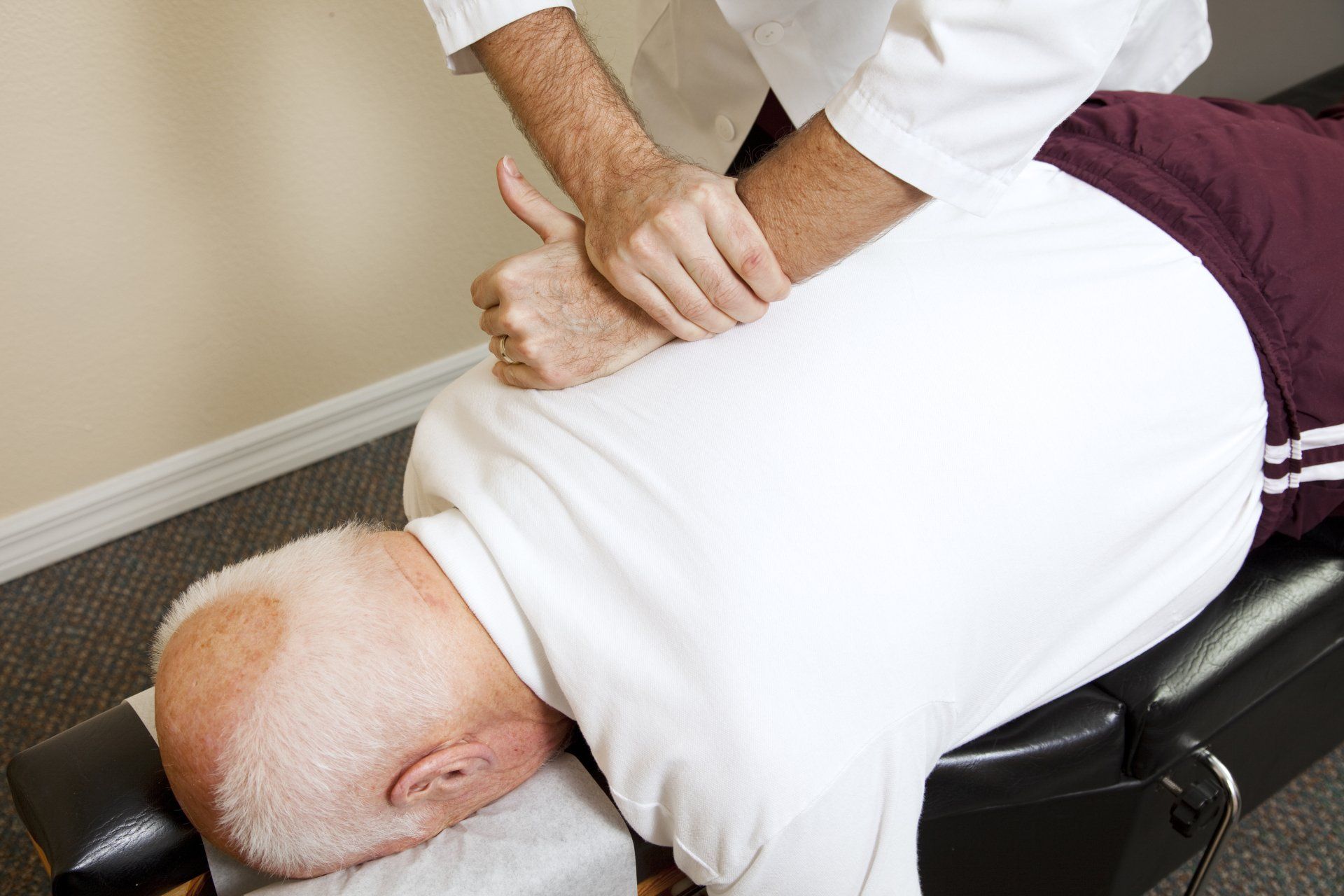Osteopath or Chiropractor, which is Better for You?
Grappin Clinic • July 23, 2024
The Great Debate: Osteopath vs Chiropractor – Which is Better?

You’ve no doubt heard of osteopaths and chiropractors before, but you may not be sure which one is most suited to treat your condition. While both professions may use significantly similar approaches to treatment, there are some differences. In this article, we’ll take a look at both professions, how they compare, and what treatments they offer. Armed with this information, you will be able to select the treatment that suits your specific needs and be on the road to recovery and relief from pain before you know it.
What is an osteopath and what do they do?
According to the NHS, osteopathy can be effective in the treatment of neck, shoulder, and lower limb pain and can also aid recovery from hip and knee operations. If you suffer from arthritis, sciatica, postural imbalances, or muscle or joint strain, visiting an osteopath for treatment can also be beneficial.
Osteopaths must complete a degree or postgraduate master’s degree approved by the General Osteopathy Council (GOsC). The qualification usually takes 4 years and osteopaths must also be registered with the GOsC before they can offer treatment to patients. Some osteopaths take their postgraduate studies further to become sports injury specialists. You do not need a referral to visit an osteopath.
What is a chiropractor and what do they do?
Like osteopathy, chiropractic is also considered a complementary and alternative medicine. The word ‘chiropractic’ means ‘done by hand’ and involves treatments that focus solely on the spine and joints. Chiropractors treat, diagnose, and prevent a broad spectrum of mechanical disorders that could affect the musculoskeletal system. Some of these disorders can negatively impact the nervous system, preventing proper function. Similarly to osteopathy, the NHS website states that chiropractic is effective in the treatment of back, neck, shoulder and elbow pain, as well as pain from arthritis.
Chiropractic medicine is similar to osteopathic medicine in that it aims to maintain optimal health without surgery or drugs. Treatment is typically carried out on just the spine and joints, although some chiropractors may also provide soft tissue therapy, fitness coaching, advice on nutrition, and other complementary services.
Although not qualified doctors, chiropractors must undergo years of study to gain a chiropractic degree or postgraduate degree recognized by the General Chiropractic Council (GCC). They are also trained to perform X-rays. Chiropractors need to periodically update their skills and knowledge in line with the latest advancements in the industry. You do not need a referral to visit a chiropractor.
How do osteopaths and chiropractors compare?
If you compare what osteopaths and chiropractors do, you’ll notice there are distinct similarities between the two professions. There’s a good reason for this – osteopathy was invented by Dr. Andrew Taylor Still in 1872 and chiropractic medicine was developed a few years later by Dr. Daniel David Palmer, a student of Dr. Still.
The primary difference between osteopathy and chiropractic treatment is that osteopaths diagnose and treat problems with muscles, bones, and soft tissues by assessing the function of the body as a whole, while chiropractors assess the effect the muscles, bones, and soft tissues have on the nervous system, often focusing on the spine.
For example, if you have a pinched nerve, a chiropractor will use adjustments of the spine or joints to release the nerve and restore strength and range of motion.
An osteopath, on the other hand, will assess the whole body to see what contributing factors are causing the problem. They will then use gentle manipulation of the bones, muscles, or tissue accordingly to alleviate the problem. Both treatments have the same common goal – to relieve you of pain and discomfort.
Due to the different focuses of chiropractors and osteopaths, adjustments (the clicks and cracks) maybe deemed as a more important part of a chiropractor’s treatment compared to an osteopath, though both types of practitioner may choose to use them.
Due to osteopaths using more slower techniques, such as mobilizations, you may find session times are a bit longer. You may also find that chiropractors use more short-lever techniques, meaning they will put pressure on areas close to the joint to cause movement, whereas osteopaths may use more long-lever techniques, for example, moving your legs to cause movement in your lower back. However, both practitioners are trained to use both types of techniques.
How is chiropractic treatment delivered?
Chiropractic treatment is all about the art of adjustment. Using their hands and sometimes a special chiropractic instrument, chiropractors manipulate bones, muscles or joints to correct imbalances and misalignments. Chiropractors firmly believe that the body will start to heal itself when the structure and function of the the affected area is fixed.
Chiropractors use a range of techniques to treat conditions relating to the joints and muscles, including:
- Spinal manipulation
- Short thrusting movements
- Gradual movement of joints into different positions
- Stretching or pulling the muscles in different directions
Treatment is focused on the spine or other joints and is often carried out with a specific force and a high velocity. If you’ve ever seen chiropractic treatments in action, you might have been alarmed at the cracking and popping sounds that are generated. These sounds are normal and simply the result of small pockets of air in the fluid around the joints being released.

How is osteopathic treatment delivered?
Osteopaths use a holistic approach to treatment, regarding the human body as a whole. They are concerned with how structural faults in the body, like back misalignment, can affect physiological processes, such as walking or bending down.
Osteopathy also involves massage or touch to help loosen up and manipulate muscles, tendons and ligaments. The aim of this treatment is to increase the body’s ability to move and function as a whole system. This treatment will usually be followed up with advice on exercises or movements you can use to improve your posture and maintain your new body structure.
Osteopaths use stretching, massage, and physical manipulation to:
- Increase joint mobility
- Relieve muscle tension
- Reduce pain
- Help the body to heal
- Enhance blood support to tissues
During your examination, your osteopath will evaluate your symptoms and recommend treatments that restabilise the whole body. For example, if you have pain in your knee, your osteopath will also treat your hip and back as these joints are associated with movement of the knee joint.
What conditions does an osteopath treat?
Osteopaths are trained and qualified to treat a wide variety of conditions that affect the bones, joints, and muscles, such as:
- Lower back pain
- Neck pain (uncomplicated pain not resulting from an injury)
- Arthritis
- Shoulder pain
- Elbow pain
- Sports injuries
- Trapped nerves
- Sciatica
- Pain in the pelvis, legs, and hips
- Headaches and migraines
- Carpal tunnel syndrome
- Muscles and joint pain connected with work, driving, or pregnancy
What conditions are treated by chiropractors?
Chiropractic can be used to treat a variety of conditions, including:
- Ankle sprain (short-term management)
- Cramp
- Elbow pain and tennis elbow (lateral epicondylitis) arising from associated musculoskeletal conditions of the back and neck, but not isolated occurrences
- Headache arising from the neck (cervicogenic)
- Joint pains
- Joint pains including hip and knee pain from osteoarthritis as an adjunct to core OA treatments and exercise
- General, acute & chronic backache, back pain (not arising from injury or accident)
- Generalized aches and pains
- Lumbago
- Mechanical neck pain (as opposed to neck pain following injury i.e. whiplash)
- Migraine prevention
- Minor sports injuries
- Muscle spasms
- Plantar fasciitis (short-term management)
- Rotator cuff injuries, disease or disorders
- Sciatica (General references, as opposed to pain reduction claims – see ASA Guidance )
- Shoulder complaints (dysfunction, disorders and pain – but not frozen shoulder – see ASA Guidance)
- Soft tissue disorders of the shoulder
- Tension and inability to relax
...... (continued at link below).....
Excerpted from article originally posted on: https://www.socotherapies.co.uk/post/osteopath-vs-chiropractor

























